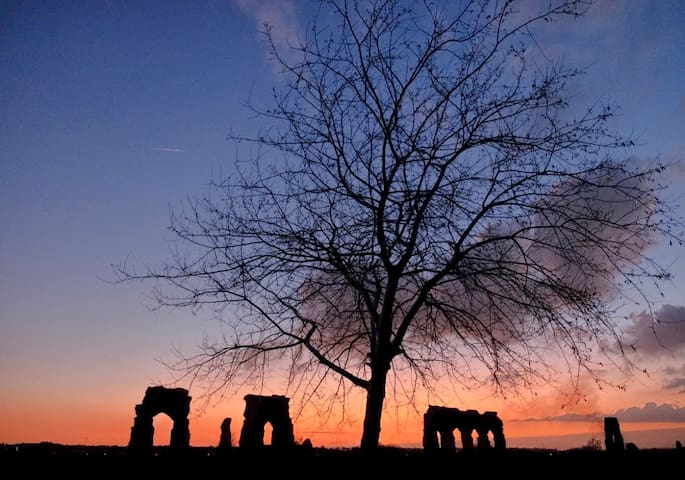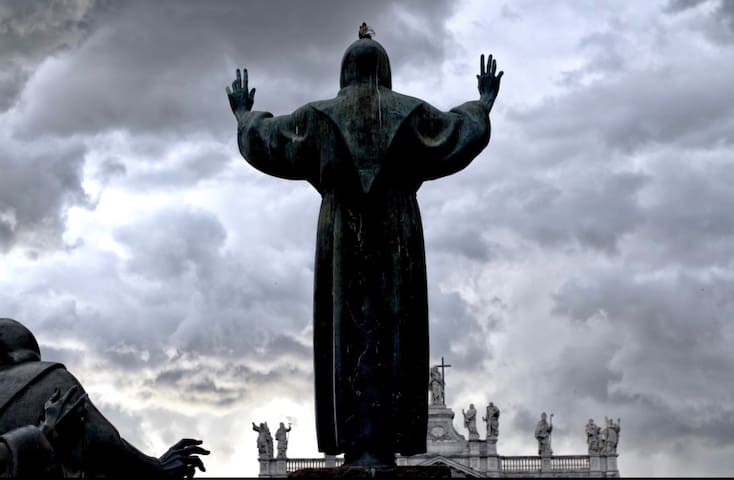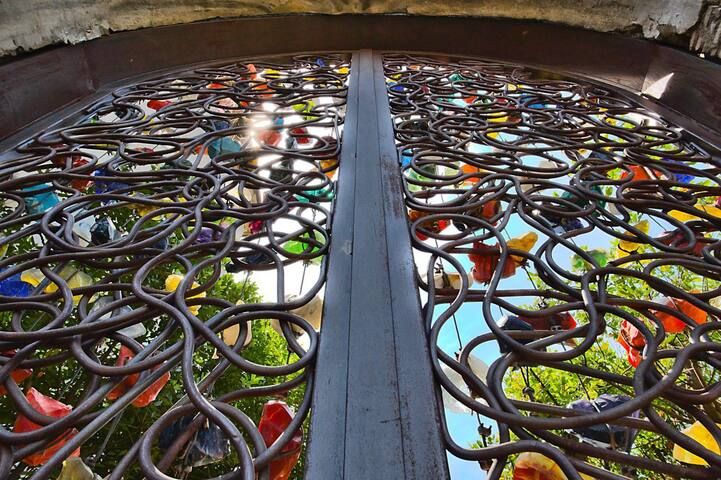Visite turistiche
How to get there:
METRO A Re di Roma - Lucio sestio (7 stops, and a few minutes to walk from Lucio Sestio).
One of the most fascinating parks in Rome is enclosed between Via Appia and Via Tuscolana and covers about 240 hectares, among the scenic attractions of the Roman countryside up to the Castles and an atmosphere suspended in time, enjoyable especially in the pink light of sunset, when the imposing arches of the Claudio aqueduct and the Felice aqueduct, framed by pine trees, stand out.
In the area there are seven aqueducts: the Anio Vetus, the Anio Novus, that of the Aqua Marcia, the Tepula, the Iulia aqueduct, that of the Aqua Claudia and the Felice Aqueduct, still functioning, built in 1585 by Pope Sixtus V, Felice Peretti, on the arches of the Marcio A In addition to the aforementioned aqueducts, in this area there are other interesting ancient buildings, including the villa delle Vignacce, the farmhouse of Roma Vecchia and the Villa dei Sette Bassi.
274 personas locales recomiendan
Parco degli Acquedotti
221 Via LemoniaHow to get there:
METRO A Re di Roma - Lucio sestio (7 stops, and a few minutes to walk from Lucio Sestio).
One of the most fascinating parks in Rome is enclosed between Via Appia and Via Tuscolana and covers about 240 hectares, among the scenic attractions of the Roman countryside up to the Castles and an atmosphere suspended in time, enjoyable especially in the pink light of sunset, when the imposing arches of the Claudio aqueduct and the Felice aqueduct, framed by pine trees, stand out.
In the area there are seven aqueducts: the Anio Vetus, the Anio Novus, that of the Aqua Marcia, the Tepula, the Iulia aqueduct, that of the Aqua Claudia and the Felice Aqueduct, still functioning, built in 1585 by Pope Sixtus V, Felice Peretti, on the arches of the Marcio A In addition to the aforementioned aqueducts, in this area there are other interesting ancient buildings, including the villa delle Vignacce, the farmhouse of Roma Vecchia and the Villa dei Sette Bassi.
How to get there: 5 /10 minutes to walk from home.
Basilica of San Giovanni in Laterano, also defined as the Cathedral of Rome (full name Papal archbasilica major archpriest cathedral of the Most Holy Saviour and Saints John the Baptist and Evangelist in Lateran; in Latin: Archibasilica Sanctissimi Salvatoris et Sanctorum Ioannis Baptistae et Ioannis Evangeli It is the first of the four major papal basilicas and the oldest and most important basilica in the West. Located on the hill of the Celio, the basilica is the material representation of the Holy See, which has its residence here.
It is the oldest basilica in the West and cathedral in Rome. The land on which it stands was donated to the Church by Emperor Constantine, fresh from conversion, as a thank you for the victory of Ponte Milvio. It was Pope Miltiades who built the first basilica there, shortly after the edict of Milan (313). Fires, earthquakes and looting have necessitated its reconstruction three times. The current basilica dates back to the seventeenth century, when Pope Alexander VII entrusted the project to Francesco Borromini, while the facade is due to the architect Alessandro Galilei
(1732). Of the previous structures were preserved the Cosmatesque floor, the apse mosaic and the grandiose ciborium. The Borrominian building with five naves has a spectacular coffered ceiling and is richly adorned with frescoes, polychrome marbles, plant and floral motifs, as well as the 12 eighteenth-century statues of the Apostles. Among the treasures of the basilica are the chapels Massimo, Torlonia and Casati, two precious ciboriums, respectively Gothic and Baroque, the medieval mosaic of the apse and the early Christian mosaic of the facade, the Roman statue of Constantine, the relics of Saints Peter and Paul and the last table of Christ.
806 personas locales recomiendan
Arcibasilica di San Giovanni in Laterano
4 Piazza di S. Giovanni in Laterano How to get there: 5 /10 minutes to walk from home.
Basilica of San Giovanni in Laterano, also defined as the Cathedral of Rome (full name Papal archbasilica major archpriest cathedral of the Most Holy Saviour and Saints John the Baptist and Evangelist in Lateran; in Latin: Archibasilica Sanctissimi Salvatoris et Sanctorum Ioannis Baptistae et Ioannis Evangeli It is the first of the four major papal basilicas and the oldest and most important basilica in the West. Located on the hill of the Celio, the basilica is the material representation of the Holy See, which has its residence here.
It is the oldest basilica in the West and cathedral in Rome. The land on which it stands was donated to the Church by Emperor Constantine, fresh from conversion, as a thank you for the victory of Ponte Milvio. It was Pope Miltiades who built the first basilica there, shortly after the edict of Milan (313). Fires, earthquakes and looting have necessitated its reconstruction three times. The current basilica dates back to the seventeenth century, when Pope Alexander VII entrusted the project to Francesco Borromini, while the facade is due to the architect Alessandro Galilei
(1732). Of the previous structures were preserved the Cosmatesque floor, the apse mosaic and the grandiose ciborium. The Borrominian building with five naves has a spectacular coffered ceiling and is richly adorned with frescoes, polychrome marbles, plant and floral motifs, as well as the 12 eighteenth-century statues of the Apostles. Among the treasures of the basilica are the chapels Massimo, Torlonia and Casati, two precious ciboriums, respectively Gothic and Baroque, the medieval mosaic of the apse and the early Christian mosaic of the facade, the Roman statue of Constantine, the relics of Saints Peter and Paul and the last table of Christ.
How to get to the place :
1) Recommended bicycle, so that you can fully appreciate the magnificence of the ancient Appia and be able to visit the park.
-proceed on via Appia to the crossroads with via del almone, always continue straight on via del almone and you will have arrived.
-Estimated time 16 minutes
,distance 4.5km.
2) Reach Ancient Appia by bus: take a 85 bus (via Taranto/via Aosta )and get off at the arco di travertino stop, from arco di travertino take the 660 bus and get off at Appia Pignatelli / Almone .
Estimated time 35/40 minutes.
The Ancient Appia- The queen viarum
The Appia Way is known to everyone, at least by name.
The path of this consular road, which can be defined as the foreign of modern roads, starts from Rome and reaches Brindisi, at the time a very important port that connected the Italian peninsula with Greece and the East.
Some traits of the Appia Antica are still visible and practicable, while others represent a real treasure to visit and observe, especially for fans of archaeology. Living on the Ancient Appia means choosing to live in an area of great historical and cultural interest, along the stretch that the Romans, between the fourth and third centuries BC, decided it was the best route for their trades and trades.
On the other hand, no other road can boast of the name of ‘queen viarum’, that is, the ‘queen of the streets’.
Along the Ancient Appia, the wonders of Roman civilization add up to those of nature. Mausolei, villas, catacombs, temples, but also undulating hills, fertile cultivated fields and sea pines that stand out against the blue background. The Appia Antica is certainly one of the most interesting areas of central Italy to live in, well connected to the center of the capital and which, at the same time, enjoys the tranquility of the Albani Hills.
The stretch of the Appia, which is included in the borders of the capital Rome, goes from the I mile, from Porta Capena to Porta S. Sebastian, up to the ninth mile, in Bovillae. A path so rich in archaeological testimonies that I can't mention them all. Every stretch, every corner reserves a surprise, so much so that you get used to living in a privileged place.1
183 personas locales recomiendan
Via Appia Antica
Via Appia AnticaHow to get to the place :
1) Recommended bicycle, so that you can fully appreciate the magnificence of the ancient Appia and be able to visit the park.
-proceed on via Appia to the crossroads with via del almone, always continue straight on via del almone and you will have arrived.
-Estimated time 16 minutes
,distance 4.5km.
2) Reach Ancient Appia by bus: take a 85 bus (via Taranto/via Aosta )and get off at the arco di travertino stop, from arco di travertino take the 660 bus and get off at Appia Pignatelli / Almone .
Estimated time 35/40 minutes.
The Ancient Appia- The queen viarum
The Appia Way is known to everyone, at least by name.
The path of this consular road, which can be defined as the foreign of modern roads, starts from Rome and reaches Brindisi, at the time a very important port that connected the Italian peninsula with Greece and the East.
Some traits of the Appia Antica are still visible and practicable, while others represent a real treasure to visit and observe, especially for fans of archaeology. Living on the Ancient Appia means choosing to live in an area of great historical and cultural interest, along the stretch that the Romans, between the fourth and third centuries BC, decided it was the best route for their trades and trades.
On the other hand, no other road can boast of the name of ‘queen viarum’, that is, the ‘queen of the streets’.
Along the Ancient Appia, the wonders of Roman civilization add up to those of nature. Mausolei, villas, catacombs, temples, but also undulating hills, fertile cultivated fields and sea pines that stand out against the blue background. The Appia Antica is certainly one of the most interesting areas of central Italy to live in, well connected to the center of the capital and which, at the same time, enjoys the tranquility of the Albani Hills.
The stretch of the Appia, which is included in the borders of the capital Rome, goes from the I mile, from Porta Capena to Porta S. Sebastian, up to the ninth mile, in Bovillae. A path so rich in archaeological testimonies that I can't mention them all. Every stretch, every corner reserves a surprise, so much so that you get used to living in a privileged place.1
Le Guide ai Quartieri
How to get there: 5 /10 minutes to walk from home.
Neighborhood with a strong sense of community identity, Pigneto was born as a garden city made up of villas and quiet streets, squeezed between two of the busiest consular streets of the capital, Via Prenestina and Via Casilina.
The heart of Pigneto is certainly its pedestrian area; famous, during the day, for the local market and the charm of some of its stubbornly retro bars and, in the evening, for aperitifs,
ethnic restaurants and nightlife.
These characteristics have attracted many students to Pigneto, also given the proximity to La Sapienza University, and many artists.
Several street artists in Rome have their own studio at Pigneto, which has therefore become one of the main districts to find street art in Rome.
60 personas locales recomiendan
Pigneto
How to get there: 5 /10 minutes to walk from home.
Neighborhood with a strong sense of community identity, Pigneto was born as a garden city made up of villas and quiet streets, squeezed between two of the busiest consular streets of the capital, Via Prenestina and Via Casilina.
The heart of Pigneto is certainly its pedestrian area; famous, during the day, for the local market and the charm of some of its stubbornly retro bars and, in the evening, for aperitifs,
ethnic restaurants and nightlife.
These characteristics have attracted many students to Pigneto, also given the proximity to La Sapienza University, and many artists.
Several street artists in Rome have their own studio at Pigneto, which has therefore become one of the main districts to find street art in Rome.
Hidden Rome
How to get there: 5 minutes to walk from home.
The portal to the vegetable garden of the Cistercian monastery of the
basilica of Santa Croce in Gerusalemme,was created in 2007 by Greek artist Janis Kounellis.
The work, consisting of a twisted wire of wrought iron, decorated with colored glass and quartz stones, was designed not to completely conceal the
view of the garden from outside, which in turn has something extraordinary.
The kitchen garden, is in fact located in the ruins of the Amphitheater
Castrense, a third-century amphitheater that was once part of a large imperial complex, of which one can still perceives the circular structure along the Aurelian Walls, into which it was incorporated
later
Orto Monastico di Santa Croce in Gerusalemme
Piazza di Santa Croce in GerusalemmeHow to get there: 5 minutes to walk from home.
The portal to the vegetable garden of the Cistercian monastery of the
basilica of Santa Croce in Gerusalemme,was created in 2007 by Greek artist Janis Kounellis.
The work, consisting of a twisted wire of wrought iron, decorated with colored glass and quartz stones, was designed not to completely conceal the
view of the garden from outside, which in turn has something extraordinary.
The kitchen garden, is in fact located in the ruins of the Amphitheater
Castrense, a third-century amphitheater that was once part of a large imperial complex, of which one can still perceives the circular structure along the Aurelian Walls, into which it was incorporated
later





